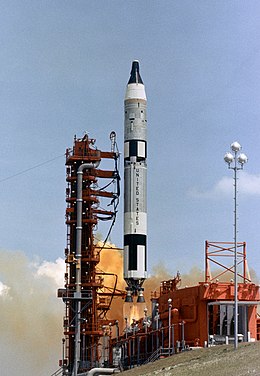Gemini 1

Launch of Gemini 1
|
|
| Mission type | Test flight |
|---|---|
| Operator | NASA |
| COSPAR ID | 1964-018A |
| SATCAT no. | 782 |
| Mission duration | 4 hours 50 minutes |
| Distance travelled | 2,789,864 kilometers (1,733,541 mi) |
| Orbits completed | 63 |
| Spacecraft properties | |
| Spacecraft | Gemini SC1 |
| Manufacturer | McDonnell |
| Launch mass | 3,187 kilograms (7,026 lb) 5,170 kilograms (11,400 lb) (with 2nd stage) |
| Start of mission | |
| Launch date | April 8, 1964, 16:01:01.69 UTC |
| Rocket | Titan II GLV, s/n 62-12556 |
| Launch site | Cape Kennedy LC-19 |
| End of mission | |
| Disposal | Uncontrolled reentry |
| Decay date | April 12, 1964, 15:00:00 UTC |
| Landing site | Middle of South Atlantic Ocean |
| Orbital parameters | |
| Reference system | Geocentric |
| Regime | Low Earth orbit |
| Perigee | 155 kilometers (84 nmi) |
| Apogee | 271 kilometers (146 nmi) |
| Inclination | 32.5 degrees |
| Period | 88.76 minutes |
| Epoch | April 10, 1964 |
|
|
|
Gemini 1 was the first unmanned test flight of the Gemini spacecraft in NASA's Gemini program. Its main objectives were to test the structural integrity of the new spacecraft and modified Titan II launch vehicle. It was also the first test of the new tracking and communication systems for the Gemini program and provided training for the ground support crews for the first manned missions.
The spacecraft stayed attached to the second stage of the rocket. The mission lasted for three orbits while test data were taken, but the spacecraft stayed in orbit for almost 64 orbits until the orbit decayed due to atmospheric drag. The spacecraft was not intended to be recovered; in fact, holes were drilled through its heat shield to ensure it would not survive re-entry.
Gemini Spacecraft Number 1 was built specifically for an unmanned mission. Crew life support systems were replaced with ballast to approximate the weight of a crewed spacecraft. Four large holes were drilled in the capsule's ablative heat shield to ensure the spacecraft was destroyed during reentry. In place of the crew couches were measuring equipment that relayed telemetry measuring the pressure, vibration, acceleration, temperature, and structural loads during the short flight.
As with any new spacecraft, there were problems at first during system testing, and also the rocket ran into problems, as the Air Force had yet to make the Titan II totally reliable as an intercontinental ballistic missile, let alone as a manned launch vehicle. One example was a short circuit discovered in the second stage, due to a wire's insulation being cut by a defective clamp. Several more were found with the same problem, meaning that 1,500 clamps had to be replaced. After several months of testing, the launch vehicle and spacecraft were finally ready for launch.
...
Wikipedia
